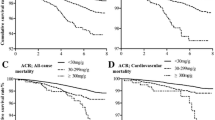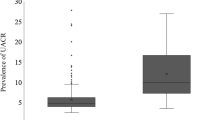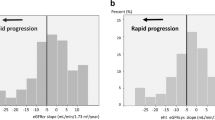Abstract
Background
Estimated glomerular filtration rate (eGFR) is the sole diagnostic criterion for stage 3a chronic kidney disease (CKD). Because eGFR decreases with age, its prognostic utility in the elderly is controversial. Albuminuria is an important prognostic factor. To confirm that eGFR use may lead to the overdiagnosis of CKD and to examine the utility of eGFR combined with albuminuria for diagnosing stage 3a CKD in the elderly.
Methods
This study included 365 elderly patients (age ≥ 65 years) who were diagnosed with stage 2 or 3a CKD. All patients had 3 years of consecutive data at our hospitals from 2000 to 2012. For each eGFR level, patients were divided into normalbuminuria (NOR, urinary albumin excretion rate [UAER] < 30 mg/24 h), microalbuminuria (30 ≥ UAER < 299 mg/24 h), and macroalbuminuria groups (UAER ≥ 300 mg/24 h).
Results
Albuminuria was associated with eGFR loss but not baseline eGFR level. When stage 2 NOR was used as a reference, the multivariable adjusted odds ratio (OR) for rapid kidney function decline (RKFD) of stage 3a NOR was 1.329 (95 % confidence interval (CI): 0.334–5.281, P = 0.686). ORs for other groups were significantly higher. In stage 3a NOR, higher ORs for RKFD were associated with younger age groups.
Conclusions
Lot of elderly patients with stage 3a CKD and normal albuminuria levels may be over-diagnosed. Albuminuria may be combined with eGFR for improved diagnosis and treatment of stage 3 CKD in the elderly.


Similar content being viewed by others
References
Coresh J, Selvin E, Stevens LA et al (2007) Prevalence of chronic kidney disease in the United States. JAMA 298(17):2038–2047
Douville P, Martel AR, Talbot J, Desmeules S, Langlois S, Agharazii M (2009) Impact of age on glomerular filtration estimates. Nephrol Dial Transpl 24(1):97–103
Stevens LA, Li S, Wang C et al (2010) Prevalence of CKD and comorbid illness in elderly patients in the United States: results from the Kidney Early Evaluation Program (KEEP). Am J Kidney Dis 55(3 Suppl 2):S23–S33
Zúñiga SMC, Müller OH, Flores OM (2011) Prevalence of chronic kidney disease in subjects consulting in urban primary care clinics. Rev Med Chil 139(9):1176–1184
Granerus G, Aurell M (1981) Reference values for 51Cr-EDTA clearance as a measure of glomerular filtration rate. Scand J Clin Lab Invest 41:611–616
Grewal GS, Blake GM (2005) Reference data for 51Cr-EDTA measurements of the glomerular filtration rate derived from live kidney donors. Nucl Med Commun 26:61–65
Xu R, Zhang LX, Zhang PH, Wang F, Zuo L, Wang HY (2010) Gender difference in age related decline in glomerular filtration rates in healthy people and chronic kidney disease patients. BMC Nephrol 23(11):20
Lin MY, Hwang SJ, Mau LW et al (2010) Impact of late-stage CKD and aging on medical utilization in the elderly population: a closed-cohort study in Taiwan. Nephrol Dial Transpl 25:3230–3235
Glassock RJ, Winearls C (2008) An epidemic of chronic kidney disease: fact or fiction? Nephrol Dial Transpl 23(4):1117–1121
Stengel B, Metzger M, Froissart M et al (2011) Epidemiology and prognostic significance of chronic kidney disease in the elderly—the Three-City prospective cohort study. Nephrol Dial Transpl 26(10):3286–3295
Bello AK, Hemmelgarn B, Lloyd A et al (2011) Associations among estimated glomerular filtration rate, proteinuria, and adverse cardiovascular outcomes. Clin J Am Nephrol 6(6):1418–1426
Kurella Tamura M, Muntner P, Wadley V et al (2011) Albuminuria, kidney function, and the incidence of cognitive impairment among adults in the United States. Am J Kidney Dis 58(5):756–763
Obi Y, Kimura T, Nagasawa Y et al (2010) Impact of age and overt proteinuria on outcomes of stage 3 to 5 chronic kidney disease in a referred cohort. Clin J Am Soc Nephrol 5(9):1558–1565
Gansevoort RT, Matsushita K, van der Velde M et al (2011) Lower estimated GFR and higher albuminuria are associated with adverse kidney outcomes. A collaborative meta-analysis of general and high-risk population cohorts. Kidney Int 80(1):93–104
Grams ME, Astor BC, Bash LD, Matsushita K, Wang Y, Coresh J (2010) Albuminuria and estimated glomerular filtration rate independently associate with acute kidney injury. J Am Soc Nephrol 21(10):1757–1764
Kim BJ, Lee HA, Kim NH et al (2011) The association of albuminuria, arterial stiffness, and blood pressure status in nondiabetic, nonhypertensive individuals. J Hypertens 29(11):2091–2098
Usui T, Ninomiya T, Nagata M et al (2011) Albuminuria as a risk factor for peripheral arterial disease in a general population: the Hisayama study. J Atheroscler Thromb 18(8):705–712
van der Velde M, Matsushita K, Coresh J et al (2011) Lower estimated glomerular filtration rate and higher albuminuria are associated with all-cause and cardiovascular mortality. A collaborative meta-analysis of high-risk population cohorts. Kidney Int 79(12):1341–1352
Waheed S, Matsushita K, Sang Y et al (2012) Combined association of albuminuria and cystatin C-based estimated GFR with mortality, coronary heart disease, and heart failure outcomes: the Atherosclerosis Risk in Communities (ARIC) Study. Am J Kidney Dis 60(2):207–216
Hallan SI, Ritz E, Lydersen S, Romundstad S, Kvenild K, Orth SR (2009) Combining GFR and albuminuria to classify CKD improves prediction of ESRD. J Am Soc Nephrol 20(5):1069–1077
Matsushita K, Selvin E, Bash LD, Franceschini N, Astor BC, Coresh J (2009) Change in estimated GFR associates with coronary heart disease and mortality. J Am Soc Nephrol 20:2617–2624
Shlipak MG, Katz R, Kestenbaum B et al (2009) Rapid decline of kidney function increases cardiovascular risk in the elderly. J Am Soc Nephrol 20:2625–2630
Al-Aly Z, Zeringue A, Fu J et al (2010) Rate of kidney function decline associates with mortality. J Am Soc Nephrol 21:1961–1969
Kilbride HS, Stevens PE, Eaglestone G et al (2013) Accuracy of the MDRD (Modification of Diet in Renal Disease) study and CKD-EPI (CKD Epidemiology Collaboration) equations for estimation of GFR in the elderly. Am J Kidney Dis 61(1):57–66
Korhonen PE, Kivelä SL, Aarnio PT, Kautiainen H, Järvenpää S, Kantola IM (2012) Estimating glomerular filtration rate in hypertensive subjects: comparison of the Chronic Kidney Disease Epidemiology Collaboration (CKD-EPI) and Modification of Diet in Renal Disease (MDRD) study equations. Ann Med 44(5):487–493
Matsushita K, Mahmoodi BK, Woodward M et al (2012) Comparison of risk prediction using the CKD-EPI equation and the MDRD study equation for estimated glomerular filtration rate. JAMA 307(18):1941–1951
Matsushita K, Tonelli M, Lloyd A et al (2012) Clinical risk implications of the CKD Epidemiology Collaboration (CKD-EPI) equation compared with the Modification of Diet in Renal Disease (MDRD) study equation for estimated GFR. Am J Kidney Dis 60(2):241–249
Shafi T, Matsushita K, Selvin E et al (2012) Comparing the association of GFR estimated by the CKD-EPI and MDRD study equations and mortality: the third national health and nutrition examination survey (NHANES III) examination survey (NHANES III). BMC Nephrol 13(1):42
Wu MJ, Shu KH, Liu PH et al (2010) High risk of renal failure in stage 3B chronic kidney disease is under-recognized in standard medical screening. J Chin Med Assoc 73(10):515–522
Imai E, Yamagata K, Iseki K et al (2007) Kidney disease screening program in Japan: history, outcome, and perspectives. Clin J Am Soc Nephrol 2:1360–1366
Chronic Kidney Disease Prognosis Consortium, Matsushita K, van der Velde M et al (2010) Association of estimated glomerular filtration rate and albuminuria with all-cause and cardiovascular mortality in general population cohorts: a collaborative meta-analysis. Lancet 375:2073–2081
Gansevoort RT, de Jong PE (2009) The case for using albuminuria in staging chronic kidney disease. J Am Soc Nephrol 20(3):465–468
van der Velde M, Halbesma N, de Charro FT et al (2009) Screening for albuminuria identifies individuals at increased renal risk. J Am Soc Nephrol 20(4):852–862
Brantsma AH, Bakker SJL, Hillege HL, de Zeeuw D, de Jong PE, Gansevoort RT (2008) Cardiovascular and renal outcome in subjects with KDOQI stages 1–3 chronic kidney disease: the importance of urinary albumin excretion. Nephrol Dial Transpl 23:3851–3858
Halbesma N, Kuiken DS, Brantsma AH et al (2006) Macroalbuminuria is a better risk marker than low estimated GFR to identify individuals at risk for accelerated GFR loss in population screening. J Am Soc Nephrol 17(9):2582–2590
Ishani A, Grandits GA, Grimm RH et al (2006) Association of single measurements of dipstick proteinuria, estimated glomerular filtration rate, and hematocrit with 25-year incidence of end-stage renal disease in the multiple risk factor intervention trial. J Am Soc Nephrol 17:1444–1452
Rule AD, Amer H, Cornell LD et al (2010) The association between age and nephrosclerosis on renal biopsy among healthy adults. Ann Intern Med 152:561–567
Cornell LD, Poggio ED (2011) Senile nephrosclerosis—does it explain the decline in glomerular filtration rate with aging? Nephron Physiol 119(Suppl 1):6–11
Gourtsoyiannis N, Prassopoulos P, Cavouras D, Pantelidis N (1990) The thickness of the renal parenchyma decreases with age: a CT study of 360 patients. AJR 155:541–544
Carter JL, Stevens PE, Irving JE, Lamb EJ (2011) Estimating glomerular filtration rate: comparison of the CKD-EPI and MDRD equations in a large UK cohort with particular emphasis on the effect of age. QJM 104(10):839–847
O’Hare AM, Choi AI, Bertenthal D et al (2007) Age affects outcomes in chronic kidney disease. J Am Soc Nephrol 18(10):2758–2765
van der Velde M, Bakker SJ, de Jong PE, Gansevoort RT (2010) Influence of age and measure of eGFR on the association between renal function and cardiovascular events. Clin J Am Soc Nephrol 5(11):2053–2059
Cao Y, Li W, Yang G, Liu Y, Li X (2012) Diabetes and hypertension have become leading causes of CKD in Chinese elderly patients: a comparison between 1990–1991 and 2009–2010. Int Urol Nephrol 44(4):1269–1276
Parving HH, Lehnert H, Brochner-Mortensen J et al (2001) The effect of irbesartan on the development of diabetic nephropathy in patients with type 2 diabetes. N Engl J Med 345:870–878
Strippoli GF, Craig M, Schena FP, Craig JC (2005) Antihypertensive agents for primary prevention of diabetic nephropathy. J Am Soc Nephrol 16(10):3081–3091
Hou FF, Zhang X, Zhang GH et al (2006) Efficacy and safety of benazepril for advanced chronic renal insufficiency. N Engl J Med 354(2):131–140
de Zeeuw D, Remuzzi G, Parving HH et al (2004) Proteinuria, a target for renoprotection in patients with type 2 diabetic nephropathy: lessons from RENAAL. Kidney Int 65(6):2309–2320
Ruggenenti P, Perna A, Remuzzi G (2003) Retarding progression of chronic renal disease: the neglected issue of residual proteinuria. Kidney Int 63(6):2254–2261
Stevens LA, Greene T, Levey AS (2006) Surrogate end points for clinical trials of kidney disease progression. Clin J Am Soc Nephrol 1(4):874–884
Zhang L, Wang F, Wang L et al (2012) Prevalence of chronic kidney disease in China: a cross-sectional survey. Lancet 379(9818):815–822
Nicola LD, Minutolo R, Chiodini P et al (2012) The effect of increasing age on the prognosis of non-dialysis patients with chronic kidney disease receiving stable nephrology care. Kidney Int 82(4):482–488
Hallan SI, Matsushita K, Sang Y et al (2012) Chronic Kidney Disease Prognosis Consortium. Age and association of kidney measures with mortality and end-stage renal disease. JAMA 308(22):2349–2360
Acknowledgments
This project, “The study on risk appraisal of chronic disease and health warning signs in the elderly, 2007 - 1041” was supported by the Capital Medical Development Scientific Research Fund of China.
Conflict of interest
The authors have no conflict of interest to declare.
Author information
Authors and Affiliations
Corresponding author
Rights and permissions
About this article
Cite this article
Liu, C., Chen, H., Liu, C. et al. Combined application of eGFR and albuminuria for the precise diagnosis of stage 2 and 3a CKD in the elderly. J Nephrol 27, 289–297 (2014). https://doi.org/10.1007/s40620-013-0011-6
Received:
Accepted:
Published:
Issue Date:
DOI: https://doi.org/10.1007/s40620-013-0011-6




